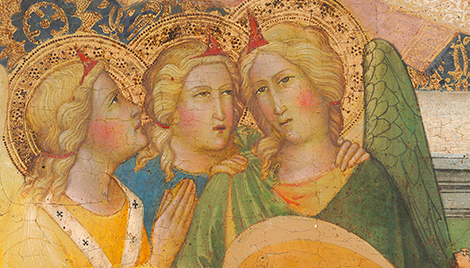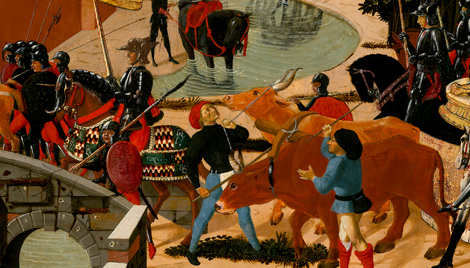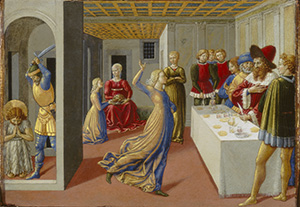The Feast of Herod and the Beheading of Saint John the Baptist
The Feast of Herod and the Beheading of Saint John the Baptist
- Artist
- Benozzo Gozzoli
- Artist Dates
- c. 1421-1497
- Artist Nationality
- Italian
- Title
- The Feast of Herod and the Beheading of Saint John the Baptist
- Date
- 1461-1462
- Medium
- tempera on poplar panel
- Dimensions
- 23.8 x 34.5 cm (9 3/8 x 13 9/16 in)
- K Number
- K1648
- Repository
- National Gallery of Art
- Accession Number
- 1952.2.3
- Notes
Provenance
Part of the predella of the altarpiece commissioned 23 October 1461 for the altar of the Compagnia della Purificazione della Vergine (also called of San Marco or of San Zanobi) [Confraternity of the Purification of the Virgin] in the confraternity's meeting place near the church of San Marco, Florence; [1] transferred 1 May 1506 to the newly built Oratory of the confraternity across the street flanking San Marco,[2] and in 1570, possibly divided from the altarpiece, to the confraternity's new seat in Via San Gallo. [3] by 1757 the altarpiece, possibly no longer complete with predella, was in the refectory of the Ospedale dei Pellegrini (or del Melani) in Via San Gallo, where it remained until 1785. [4] marchese Alfonso Tacoli Canacci [1724-1801], Florence, by 1796; by inheritance to his nephew, Petro Tacoli [1773-1847], Modena. [5] Count Vittorio Cini [1885-1977], Venice, in the 1940s. [6] (Wildenstein & Co., Inc., New York); sold June 1949 to the Samuel H. Kress Foundation, New York; [7] gift 1952 to NGA. [1] This was a confraternity of young men between the ages of 13 and 21 years, already in existence in 1299 according to Giuseppe Richa, _Notizie istoriche delle chiese fiorentine_, 10 vols., Florence, 1757: 5:329-331. According to its statutes, it was founded in 1427 and since the mid-1430s met in a space belonging to the Convent of San Marco (see Diane Cole Ahl, "'In corpo di Compagnia.' Art and Devotion in the Compagnia della Purificazione e di San Zanobi of Florence," in _Confraternities and the Visual Arts in Renaissance Italy_, ed. Barbara Wisch and Diane Cole Ahl, Cambridge, 2000). Along with prayers and communal singing, the association also organized the performance of mystery plays (see Neride Newbigin, "The Word Made Flesh. The _Rappresentazioni_ of Mysteries and Miracles in Fifteenth Century Florence," _Christianity and Renaissance_, ed. Timothy Verdon and John Henderson, Syracuse, 1990: 262-263). For the meeting place of the Company, see Ann Matchette, "The Compagnia della Purificazione e di San Zanobi in Florence. A Reconstruction of Its Residence at San Marco," in _Confraternities..._, ed. Wisch and Cole Ahl, Cambridge, 2000. The contract between the Compagnia and the painter, published by Leopoldo Tanfani Centofanti (_Notizie di artisti tratte dai documenti pisani_, Pisa, 1897: 83-86) and Orrado Ricci ("Benozzo Gozzoli e la pala della Compagnia della Purificazione," _RivA_ 2 [1904]: 9-12), relates that the company "si rauna nella città di Firenze disopra alla chiesa di sancto Marcho aspreso all'orto di detta chiesa" ("meets in the city of Florence above the church of San Marco near the garden of said church"). This does not mean that the confraternity "had its meeting place above the church," as has been suggested (Fern Rusk Shapley, "A Predella Panel by Benozzo Gozzoli," _Gazette des Beaux-Arts_ 39 (February 1952): 78; in fact, as a reliable eighteenth-century source makes clear, the _compagnia_ met in "a room on the ground floor in the second cloister of San Marco, beside the garden" (see Serafino Maria Loddi, _Notizia de soggetti e cose più memorabili del Convento di S. Marco di Firenze_, Ms dated 1736, in the Archives of the Dominican Order at Santa Sabina in Rome; Serena Padovani consulted for Dr. Miklós Boskovits the copy in the archives of San Marco in Florence, fol. 32). [2] See Richa 1757: 5:332. An inventory dated 1518 in the Archivio di Stato, Florence ("Corporazioni religiose soppresse. Compagnia di Santa Maria della Purificazione e di San Zanobi", P.XXX, no. 8, fol. 260v) describes "Vna tauola bella jnsuldetto altare dipintouj vna Vergine choruno banbino jnchollo Et sej santj Ealtre djpinture choruna bella chornicie..." ("a beautiful panel on the above-mentioned altar, painted on it a Virgin holding the Child and six saints and other paintings with a fine frame"), published in Herbert P. Horne, "Part of a Predella Painting by Benozzo Gozzoli," _The Burlington Magazine_ 7 (1905): 383. On the date on which the painting was moved from the _compagnia_ to the "luogo dove sta il Casino de'Medici" ("place where the Casino de'Medici is located"), see Loddi 1736, fols. 32-33. Giorgio Vasari, who mentions the altarpiece, must also have seen it there (_Opere_, ed. Gaetano Milanesi, 9 vols., Florence, 1878-1885: 3:46), although he does not indicate the location or mention the predella. [3] In 1570 "per dar luogo alla fabbrica del sopra mentovato Casino, ella fu trasferita in via San Gallo, ove di presente si trova" ("to make room for the construction of the above-mentioned Casino, it [that is, the confraternity] was transferred to via San Gallo, where it is presently located"); see Loddi 1736, fol. 33. [4] An Ospizio dei Pellegrini was founded in 1685 by Domenico di Santi Melani (and thus also called Ospedale del Melani) next to the Oratorio della Compagnia della Purificazione and placed under the charge of this latter; see Richa 1757: 5:335. Richa mentions the altarpiece, but not the predella, which may already have been separated from the main panel by that date. The Ospedale and _compagnia_ were suppressed in 1784 and its property sold, after having been inventoried in August 1785 (see Annalisa Innocenti, "Dispersione degli oggetti d'arte durante la soppressionoe leopoldina," _RivA_ 44 (1992): 351-385). It seems practically certain that the "cinque quadretti traversi larghi soldi 12 di braccia alti 8 soldi" described in the inventory of 1785 are the five panels of the already dismembered predella (the measure of one _soldo di braccia_ is equivalent to about 3 cm). Another of the stories on the predella, _The Fall of Simon Magus_ from the life of Saint Peter, now in the British Royal Collection, was acquired in Italy sometime between 1791 and 1798. [5] The printed _Catalogue raisonné, ou description exacte de plusieurs excellens tableaux...dans un recueil appurtenant à monsieur le marquis Alphonse Tacoli Canacci à Florence_, Parma, 1796, includes, apart from NGA 1952.2.3, the _Presentation_ now in Philadelphia, whereas the manuscript version of 1789 now in the Real Biblioteca, Madrid (MSII/574, no. 86) omits them and lists instead (as nos. 87, 88 and 100) the predella panels today in Berlin and Milan and the main altarpiece itself, which probably were already sold by 1796. On the _marchand-amateur_ Tacoli Canacci, see Alessandra Talignani "La Collezione dei dipinti toscani del Marchese Alfonso Tacoli Canacci," in _Parma nell'Arte_ [1986]: 31-42. After Tacoli Canacci's death in 1801, his collection was inherited by nephew, Pietro Tacoli, and dispersed. [6] Vittorio Cini in 1942 bought several fifteenth century Florentine paintings in Modena (see Federico Zeri's introduction to _Dipinti ferraresi dalla Collezione Vittorio Cini_, Vicenza, 1990: xi-xiii). It is probable that this panel comes from the same source. [7] The Wildenstein invoice to the Kress Foundation for 16 items, including the Gozzoli painting, is dated 23 June 1949 (copy in NGA curatorial files).






